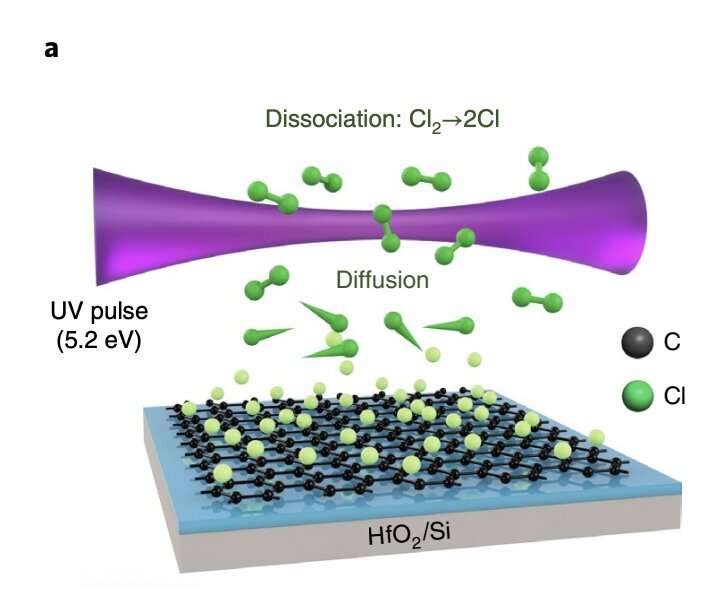September 5, 2022 feature
A new laser-based chlorination process to create high doping patterns in graphene

In recent years, electronics and chemical engineers have devised different chemical doping techniques to control the sign and concentration of charge carriers in different material samples. Chemical doping methods essentially entail introducing impurities into materials or substances to change their electrical properties.
These promising methods have been successfully applied on several materials including van der Waals (vdW) materials. VdW materials are structures characterized by strongly bonded 2D layers, which are bound in the third dimension through weaker dispersion forces.
Researchers at University of California, Berkeley (UC Berkeley), the Kavli Energy Nanosciences Institute, Beijing Institute of Technology, Shenzhen University, Tsinghua University recently introduced a new tunable and reversible approach to chemically dope graphene. Their approach, introduced in a paper published in Nature Electronics, is based on laser-assisted chlorination.
"Conventional methods based on substitutional doping or surface functionalization result in the degradation of electrical mobility due to structural disorder, and the maximum doping density is set by the solubility limit of dopants," Yoonsoo Rho and his colleagues wrote in their paper. "We show that a reversible laser-assisted chlorination process can be used to create high doping concentrations (above 3 × 1013 cm−2) in graphene monolayers with minimal drops in mobility."
To implement their approach, Rho and his colleagues used an ultraviolet (UV) nanosecond laser beam, with a wavelength of λ=213 nm (5.8 eV). They aligned this beam parallel to the surface of their sample, under a flowing Cl2 gas.
The focused UV pulsed laser can photochemically dissociate the Cl2 molecules, generating Cl radicles that diffuse throughout the graphene sample. After they applied their method to a graphene sample, the researchers collected measurements to determine its effects on the charge carriers' density and mobility.
Subsequently, the team used a photothermal process to remove the Cl doping agent. This process employed a continuous-wave (CW) green laser with a wavelength of (λ=532 nm (2.3 eV)), which was applied in the normal direction with a focal size of 2 μm (1/e2 ).
"Our approach uses two lasers—with distinct photon energies and geometric configurations—that are designed for chlorination and subsequent chlorine removal, allowing highly doped patterns to be written and erased without damaging the graphene," Rho and his colleagues wrote in their paper.
To evaluate their reversible doping method, the team used it to create re-writable photoactive junctions for graphene-based photodetectors. They found that their laser-assisted chlorination method resulted in saturable ultrahigh-doping concentrations, producing a minimal drop in the mobility of charge carriers. In addition, when removing the Cl dopant, the doped patterns were fully erased, without causing any structural damage to the graphene.
In the future, the laser-assisted approach introduced by this team of researchers could be used to introduce different doping elements in 2D van der Waals materials. This could in turn enable the reversible introduction of valuable electronic functionalities for optoelectronic devices.
More information: Yoonsoo Rho et al, A laser-assisted chlorination process for reversible writing of doping patterns in graphene, Nature Electronics (2022). DOI: 10.1038/s41928-022-00801-2
© 2022 Science X Network





















